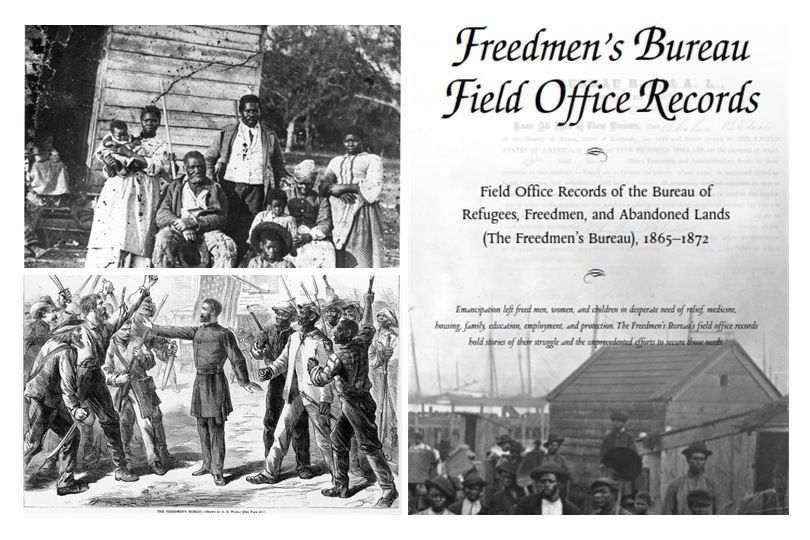The Bureau of Refugees, Freedmen, and Abandoned Lands... ...often referred to as the Freedmen's Bureau, was established in the War Department by an act of March 3, 1865. The Bureau supervised all relief and educational activities relating to refugees and freedmen, including issuing rations, clothing and medicine. They were also given confederate land that was abandoned or confiscated during war
During this period, U.S. Government policy focused upon acquiring Indian lands, restricting cultural and religious practices and sending Native American children to boarding schools. Christian organizations, promoted rapid assimilation of children through off-reservation Indian boarding schools and immersion in white culture.
December 1982: Reconstruction Revisited - The Promise of American History Progress and Prospects by Eric Foner
Excerpt
For much of this century, Reconstruction historiography was dominated by a "traditional" interpretation that portrayed the years following the Civil War as ones of unrelieved sordidness in political and social life.2 In this view, vindictive Radical Republicans fastened black supremacy upon the defeated South, unleashing an orgy of corruption presided over by unscrupulous carpetbaggers, traitorous scalawags, and ignorant freedmen. Eventually, the white community of the South overthrew this misgovernment and restored Home Rule (a euphemism for white supremacy).
Excerpt
Not until the 1960s, under the impact of the Second Reconstruction, was the full force of this Reconstruction "revisionism" felt. Modern revisionism radically reinterpreted national Reconstruction politics, and placed the activities and aspirations of blacks at the center stage of the drama in the South. President Johnson was now portrayed as a stubborn, racist politician, whereas his abolitionist and Radical opponents, acquitted of vindictive motives, emerged as idealists in the best nineteenth-century reform tradition.
Building upon the findings of the revisionists, recent writers have reached conclusions rather different in emphasis. Eric McKitrick, John and LaWanda Cox, and other revisionists had challenged the traditional notion that Radicals dominated the post-Civil War Congresses, emphasizing instead the guiding hand of moderate Republicans in drafting Reconstruction legislation. They did not doubt, however, that these laws marked a major departure in American politics and race relations.
In the 1970s, Michael Les Benedict used the prominence of moderate Republicans to challenge the idea of Radical Reconstruction itself, emphasizing instead how federal policy was guided by the goal of "preserving the Constitution" and minimizing changes in federal- state relations. Similarly, Michael Perman argued that northern Reconstruc- tion strategy eschewed radical departures in favor of seeking the cooperation of southern whites, and was therefore extremely vulnerable to southern obstructionism. A similar emphasis informed the massive study of the Grant administration's Reconstruction policy by William Gillette, which suggested that the North's commitment to the freedmen had never been particularly strong. The final collapse of Reconstruction in 1877, Gillette demonstrated, merely formalized a steady retreat throughout the 1870s.
Excerpt
The reevaluation of freedmen's education, to take one example, seemed often to view the 1860s through the lens of the 1960s. One study criticized northern educators for lacking a commitment to "black power and pride"-rallying cries of the Second Reconstruction but not necessarily major concerns of the first.
In early Reconstruction, blacks turned to ministers, ex-soldiers, free blacks, and men who had, for one reason or another, achieved prominence as slaves, to represent them politi- cally. During Congressional Reconstruction, new men came to the fore, most prominently black artisans, who possessed the skill, independence, and often, literacy that marked them as leaders, but who were still deeply embedded in the life of the freedmen's community. Such individuals were uniquely suited to serve as a bridge between the black world and the public political sphere dominated by whites.
Excerpt
Attention to these and less studied issues such as the changing incidence of taxation, the use of convict labor, and the regulation of hunting and fishing rights, reveals a vastly different pic- ture of Republican Reconstruction than the conservative interlude portrayed in much recent literature. Reconstruction stands as a unique moment between two periods when the law was molded with one idea in mind-to maintain the plantation economy. If Reconstruction did not destroy the planter class, it did prevent the putting into place of a comprehensive legal code meant to shape the political economy of emancipation in the planters' interests. Even the refusal of Republican governments to enact labor control measures was itself a significant departure from the pattern in other postemancipation societies.
Excerpt
Petty incidents-the failure of a freedman to yield the sidewalk or to address a former employer with the proper deference- sparked seemingly irrational acts of violence. Indeed, the very pervasiveness of violence in the post-Civil War South may be considered an indication of how high were the stakes being fought over. Reconstruction's promise cer- tainly exceeded its accomplishments. Yet so long as Reconstruction survived, so too did the possibility of further change, a prospect only foreclosed with Redemption and, later, the final implementation of segregation and disfran- chisement. If, in retrospect, the outcome of the postemancipation struggle appears all but inevitable, it is equally certain that Reconstruction trans- formed the lives of southern blacks in ways unmeasurable by statistics and in areas unreachable by law. It raised blacks' expectations and aspirations, rede- fined their status in relation to the larger society, and allowed space for the creation of institutions that enabled them to survive the repression that followed. Its legacy deserves to survive as an inspiration to those Americans, black and white alike, who insist that the nation live up to the professed ideals of its political culture.
When was the Freedmen's Bureau established?
The Freedmen's Bureau was established under the Freedmen's Bureau Bill on March 3, 1865. It was intended to last for the duration of the Civil War and for one year afterwards, however it continued until July 1, 1869.
Video: Reconstruction and the Freedmen's Bureau
After the divisive, destructive Civil War, Abraham Lincoln had a plan to reconcile the country and make it whole again. Then he got shot, Andrew Johnson took over, and the disagreements between Johnson and Congress ensured that Reconstruction would fail. The election of 1876 made the whole thing even more of a mess, and the country called it off, leaving the nation still very divided. John will talk about the gains made by African-Americans in the years after the Civil War, and how they lost those gains almost immediately when Reconstruction stopped. You'll learn about the Freedman's Bureau, the 14th and 15th amendments, and the disastrous election of 1876.
The Freedmen's Bureau Online
It issued food and clothing, operated hospitals and temporary camps, helped locate family members, promoted education, helped freedmen legalize marriages, provided employment, supervised labor contracts, provided legal representation, investigated racial confrontations, settled freedmen on abandoned or confiscated lands, and worked with African American soldiers and sailors and their heirs to secure back pay, bounty payments, and pensions.
During its years of operation, the Freedmen’s Bureau fed millions of people, built hospitals and provided medical aid, negotiated labor contracts for ex-slaves and settled labor disputes. It also helped former slaves legalize marriages and locate lost relatives, and assisted black veterans.
Freedmen's Education
At first, the main goal of the bureau was to just give food, clothing, shelter and other necessities to help the freedmen and poor whites but then it became more focused on education. An education was going to get the people jobs and help them make better decisions.
Carlisle Indian Industrial School
At Carlisle, Pratt attempted to "Kill the Indian: Save the Man" through any means necessary. Beyond a typical military regimen, Pratt was known to use corporal punishment on students who exhibited Native behaviors to help students become dependent only on themselves.
Carlisle and similar schools remain deeply controversial; many Native Americans say they forced children to leave their families at young ages, giving up their indigenous cultures, languages, religious and spiritual beliefs, and even their names, thus doing untold psychological damage to generations of Native people.
Since the 1970s, Native American nations have founded their own schools and colleges, thus regaining control of their children's education.
Information and Resources
The Archives holds a wealth of material documenting the African American experience, and highlights these resources online, in programs, and through traditional and social media.
Discovering the Civil War Special Exhibit
In the National Archives'-produced video short "Discovering the Civil War" the creators of this exhibition share little-known facts and extraordinary discoveries found in the incomparable Civil War holdings at the National Archives. These stories are for the first time in this exhibition, the most extensive display ever assembled from these records. The video also features rarely-seen original footage from Civil War reunions in 1917 in Vicksburg, MS, and 1938 in Gettysburg, PA.
There is a companion online preview exhibit – Discovering the Civil War. Especially useful if you won’t be able to see the exhibit in DC or truly want to get a preview of what you will be seeing.
The spring edition of Prologue focused on the Civil War. Prologue magazine brings readers stories based on the rich holdings and programs of the National Archives across the nation—from Washington, DC, to the regional archives and the Presidential libraries.
Prologue on the Civil War: Special Issues
Prologue magazine brings readers stories based on the rich holdings and programs of the National Archives across the nation—from Washington, DC, to the regional archives and the Presidential libraries. Access many of articles online.
Prologue was published quarterly by the National Archives and Records Administration (NARA) for nearly 50 years. The Winter 2017–18 issue was the last printed edition.
Freedman African American Research
The Freedman's Savings and Trust Company and African American Genealogical Research
The Life of Freedman's Bank
The Demise of Freedman's Bank
The Lasting Impact of Freedman's Bank
The Financial Panic of 1873
Freedman's Bank and Family Histories
Public Downloads
All items are free to view, share, and download.
Public Downloads - Español (Spanish)
When available, we provide all our content with a Spanish version in our public download section. You can find added material from sources listed in all our articles.
Download Freedman's Educational Activities














